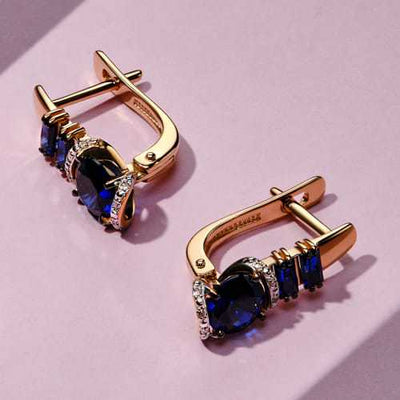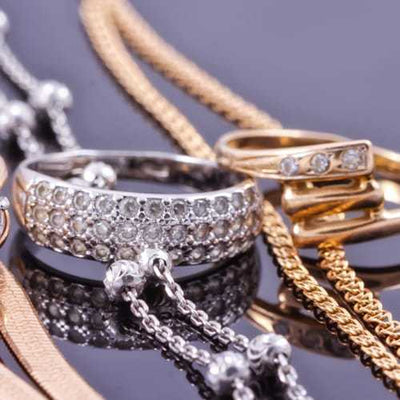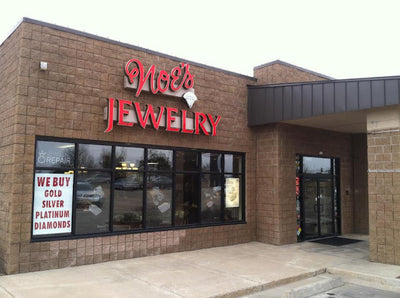Diamond and Gemstone Shapes 101
When it comes to gem and diamond quality, the cut is just one of the four Cs of gemstone grading. The cut determines the shape and the finished gem’s appearance. Standard shapes like rounds dominate the market, but there are many alternatives.
Some cuts refer to the face-up shape of the gem. Others describe the arrangement of the gem’s facets, which are patterns of geometric flat surfaces to help the stone shine. They come together to describe the cutting style. For example, princess diamonds have a square shape with a modified brilliant cutting style. Facets add to the styles and create many gem and diamond designs.
Because the cut variations are difficult for most non-professionals to follow, here is an in-depth breakdown of the most common diamond and gemstone shapes and cuts.
 Round (American Standard)
Round (American Standard)
Round is the standard shape that dominates the faceted gem market. Modern rounds with a brilliant-cut are popular because they capture the stone’s sparkle. Developed exclusively for diamonds, the round brilliant cut of today includes gemstones, too. However, the round shape is more ideal for diamond jewelry under three carats.
 Oval
Oval
The oval cut is an elegant shape for rings, as it makes your hand appear slimmer. Modern ovals use the brilliant-cut with 58 facets. The added sparkle helps hide inclusions in the stone better than some other cuts. The cut doesn’t feature any sharp corners either, creating a softer appearance.
The downside to oval cuts is called a bowtie. This type of extinction looks like a dark band across the mid-region of the stone. It’s caused by poor light and shadows. Although the flaw is less noticeable in well-cut ovals, it’s common in all oval stones.
 Octagon
Octagon
Octagon-shaped stones take on a rectangular cut with a step-cut approach to create rows of wide and flat facets, like steps in a staircase, around the gemstone. The cut is excellent for showing off a gemstone’s deep color. However, it can also showcase inclusions in the stone.
 Emerald
Emerald
While emerald cuts are named after the emerald gemstone, the cut is applied to many stone types. What makes emerald cuts popular is the ‘hall of mirrors’ effect it creates by alternating dark and light lines in a dramatic pattern. The cut doesn’t feature as much sparkle or fire as others, but it appears elegant and clean.
As the largest of the fancy gem cuts, emerald is the least forgiving with inclusions. Flaws are clearly visible. Even white diamonds will show color.
 Baguette
Baguette
Similar to the emerald cut, the baguette cut is a rectangle shape. It’s similar to a trapezoidal step cut, without any bevels and fewer facets.
 Pear
Pear
Modern pear shapes take on a brilliant-cut and 58 facets. Pears tend to show inclusions more than other fancy gem shapes, but the tip tends to hide these flaws. They make your hand look slimmer, like ovals. However, you must protect the tip against chipping and made sure the stone is just the right size.
 Heart
Heart
The heart cut has a long history, even if it’s not as popular today. Modern hearts use a brilliant cut to create symmetry, making the two halves identical. Heart shapes are best for at least a half carat-sized stone or larger. The shape doesn’t stand out as much in small sizes. For the best results, pay attention to the setting and prong positioning. They should enhance the heart outline.
 Princess
Princess
The Princess cut is like the round brilliant but square. It was invented in 1979 and popular for decades due to its modern appearance and sharp edges. Princess cuts feature varying numbers of chevron facets, which alter how the stone breaks up reflections.
The best part is that princess cuts are more affordable than the American Standard. But a huge drawback is the corners. Princess diamonds are prone to chipping, so the jewelry must include protection for longevity.
 Asscher
Asscher
An Asscher cut is like an emerald cut but smaller and square. It still has the ‘hall of mirrors’ effect and shows inclusions more than other cuts. The vintage cut has been popular in recent years.
 Marquise
Marquise
A fancy cut with the most crown surface area, the marquise cut makes the stones look larger than other cut options. The shape is thin and elongated with a brilliant cut. With two points on either end, the cut hides any inclusions thoroughly. This appears flattering in rings but also makes the stone prone to chip.
 Radiant
Radiant
Like an emerald cut, a radiant cut is a rectangle shape with beveled corners. The difference is the brilliant-cut and step-cut facets. These features make the cut more brilliant and better at hiding inclusions. Radiant cuts are great for colored gemstones over low color grade diamonds.
 Cushion (Antique or Pillow)
Cushion (Antique or Pillow)
The cushion cut is also called the antique or pillow cut. It’s a square or sometimes rectangle shape with rounded corners and sides, similar to couch cushions. The large facets cause the brilliant-cut to return less light, providing a vintage ambiance with tons of fire.
But watch out for flaws. The cushion cut is highly unforgiving. Any inclusions will show right through the large facets like windows into a stone. White diamonds also show unwanted color with this cut.
 Trilliant (Trillion)
Trilliant (Trillion)
Trilliant cuts are a triangular shape common for gemstones. It’s similar to a round brilliant. The edges are slightly rounded, and the step cuts are straight along the three sides. There are curved variations called Trillion, which are better for single stones.
These cuts are popular today because they make the stone appear larger, but they require more cleaning and a specialized setting to protect the corners. They’re an excellent value and unique shape.
There are many diamond and gemstone shapes to consider. Use the information above to examine and select your next diamond design. The right shape may depend on your jewelry and care concerns. The expert jewelers at Noe’s Jewelry can help you find the best diamond and gemstone shapes and cuts for your style.





